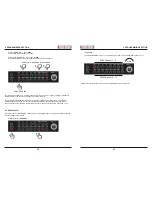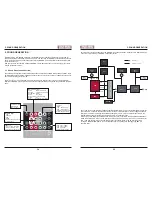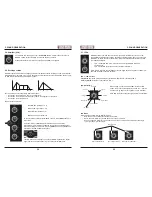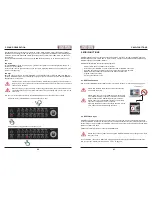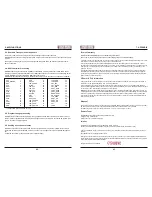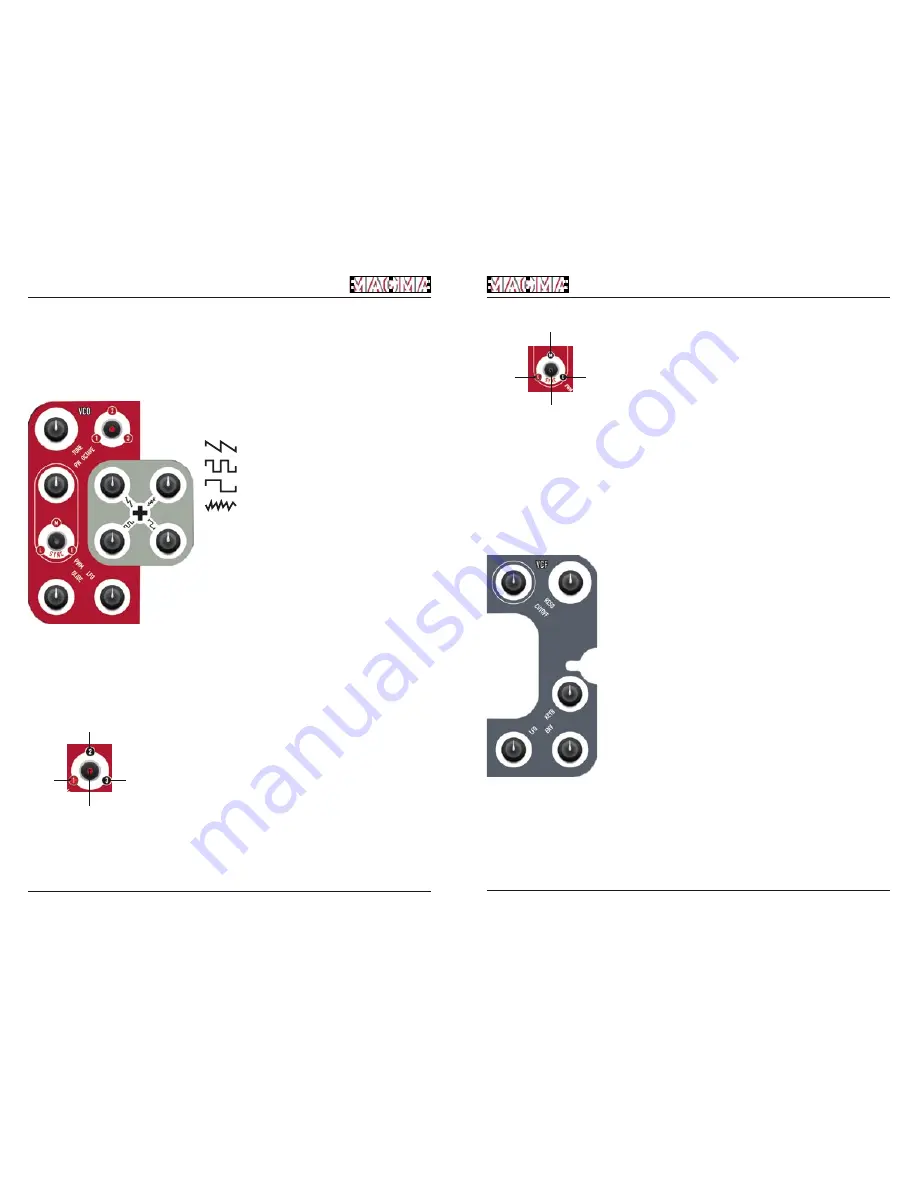
36
37
5. SOUND GENERATION
5. SOUND GENERATION
5.2. Oscillator (VCO) / Mixer
The VCO is MAGMA´s main signal source. It provides the basic waveforms to the module next in line, the
mixer. The VCO section is endowed with a sub oscillator which derives its output from the VCO´s square-
wave. A closer look at all the controls will explain the functions of both VCO and mixer.
5.2.1. Mixer
The mixer is the output stage of MAGMA´s oscillator. All
signals provided by the VCO are summed together into one
audio-signal.
: Level of
SAW
wave signal.
: Level of
SQUARE
wave signal.
: Level of
SUB
oscillator signal.
: Level of the
NOISE
signal.
Cranking up all four signals fully will cause saturation and
distortion. This can be very useful to fatten up MAGMA´s
sound. If you want a clean sound, we recommend you kee-
ping the level knobs below the 3 o‘clock setting.
All four signal levels can be individually modulated by
LFO 2.
Hit
SHIFT
and keep it depressed while moving one of the
WAVEFORM
knobs as this will apply a specific modulation
depth to the selected waveform level.
5.2.1. VCO
TUNE:
Global tune. Tunes the VCO and the sub-oscillator within the range of one semitone.
The tune setting will not be stored as part of a preset.
OCTAVE:
Controls the octave setting of both the VCO and the sub oscillator.
The three LEDs around the octave button display the octave setting of
the VCO.
The LED in the central button displays the octave setting of the sub-
oscillator, depending on the setting of the VCO.
Hit the button eight times to cycle through all possible settings.
PW:
Controls the PULSE-WIDTH of the square-wave manually from 50% to 95%.
When the pulse-width of the square-wave is modulated (see below), this knob controls the modulation
depth applied by LFO 1 or envelope 2.
SYNC / PWM:
This button has two related functions. Firstly, it synchronises the
sub-oscillator to the VCO which will result in interesting timbres when
changing the pitch of the VCO.
Secondly, it selects the modulation source for the pulse-width modu-
lation (PWM) of the square-wave.
The three LEDs around the sync button display the PWM source. The
LED in the button displays the state of the oscillator-sync function.
Hit the button six times to cycle through all possible settings.
GLIDE:
Adjusts the glide time when the glide function is active. Please refer to section 4.6.3. on page 29 how to
enable / disable the glide function.
LFO:
Adjusts the modulation depth of LFO 1, modulating VCO pitch.
5.3. Filter (VCF)
MAGMA´s filter is a classic 24 dB / four-pole low-pass design with resonance and great sonic potential.
Let‘s have a closer look at it:
CUTOFF:
Adjusts the cut-off frequency. When turned fully counter-clockwise, there
might be no signal audible (no-pass, so to speak…).
RESO:
Adjusts the resonance intensity of the filter. Higher settings will cause the
filter to self-oscillate which results in feedback. Please handle the reso-
nance pot (here it is again!) with care – feedback might reach excessive
levels, depending on the cut-off frequency setting. Do not blow your twee-
ters or your ear-drums!
The lower three knobs are used to modulate the filter cut-off frequency:
LFO:
Adjusts the modulation depth of LFO 1 modulating the VCF cut-off frequen-
cy.
ENV:
Adjusts the modulation depth of envelope 2 modulating the VCF cut-off
frequency.
Pressing SHIFT while moving the ENV knob will yield an inverted modulati-
on curve.
KEYB:
Adjusts the keyboard tracking value of the VCF frequency. Keyboard tra-
cking makes higher notes sound increasingly brighter.
You can run an external audio signal (e.g. a drum machine) into MAGMA´s filter for processing sound.
Connect this signal (line level) to the Input socket on MAGMA´s rear panel. Adjust the input level with the
trimmer found next to the input socket.
Please note that the external signal has to have line level. The signal is fed directly into the filter input, thus
it will only be attenuated, not amplified.
+1
+2
+3
Octaves
OFF
: SUB-Osc.
-1
Octave
ON
: SUB-Osc.
-2
Octave
Octaves
Octave
Manual (PW Knob)
Sync ON / OFF
LFO 1
ENV 2
Summary of Contents for EOwave
Page 23: ......













